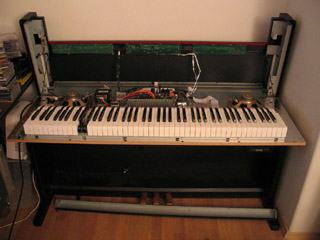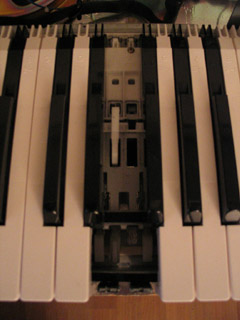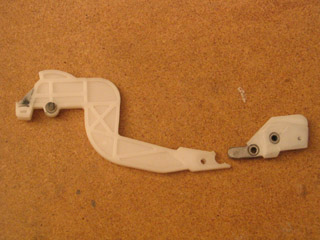you are here [x]: Scarlet Star Studios > the Scarlet Letters > piano repair
<< before
lsgl: stampede music
after >>
cola war!
August 8, 2007
piano repair
by sven at 2:47 pm

I've had a broken F on my electric piano since about January... With the soundtrack work that I've been doing for Let Sleeping Gods Lie, it was finally time to make the repair.
I've got an HP 2800G Roland digital piano. It has weighted keys; one of the counterbalances broke and needed to be replaced. This was my second time making this kind of repair on the instrument.

I found replacement parts at Keyboard Engineering, Inc./The Master's Touch Music Store @ 3213 NE Sandy Blvd. They could special order a replacement counterweight for $15, or sell me a used one on the spot for $5. (Thank you, Gretchin, for doing the initial research!)
I bought five used counterweights, expecting that I'll probably need to make this repair again at some point. I'd probably be wise to even get a few more (including counterweights for the black keys, which are shaped differently) -- there's no telling when Roland may stop producing these parts.
I'm known for playing loudly, but I don't think that the break is entirely my fault. The counterbalances inherently take a lot of stress... I could see, rumaging though a bag of used parts at the store, that stress cracks are common.

There are hinges at the back of the piano so the whole top can swing up and back. To open it up, you need to remove the 8 screws on the bottom of the instrument that are recessed, and 6 small screws on the back (the ones that aren't associated with the hinges).
Once the top of the piano is off, you also need to remove the front guard in order to access the keys. There are 6 screws underneath the guard to remove, and then 2 (on either side) which are located inside the piano itself.
The keys come off at their hinge point. Putting them on and taking them off depends on the flexibility of the plastic: just slightly expand the key with your finger, and it pops off the hinge easily. The lubrication appears to be a dark gray teflon grease -- so be aware that you'll probably get some on your hands.
Everything else should be self-apparent when you get to this point.
Mostly I'm writing out these notes for myself, so it'll go faster the next time I have to do this.
posted by sven | August 8, 2007 2:47 PM | categories: let sleeping gods lie, music